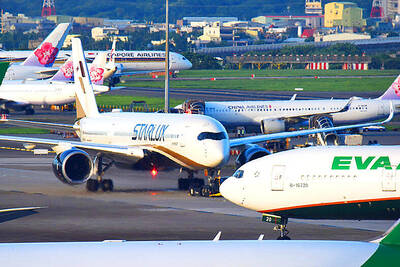While dust from arid river beds during dry season has long compromised air quality in central and eastern Taiwan, the Environmental Protection Administration (EPA) yesterday touted its preliminary success in riverbed dust control with a cost-effective “step island plantation” method.
Responsibility for the dust problem at certain rivers has yet to be identified, however, since the pollution may not be a completely natural occurrence.
“In the past, dust suppression techniques at dried riverbeds such as gravel mulching and straw mulching have been tried, but the riverbed dust problem has only become worse over the years,” said Hsiao Hui-chuan (蕭慧娟), director-general of the EPA’s Air Quality Protection and Noise Control.
The riverbed dust situation is worst during the two dry seasons — November to December and February to March — when northeastern fronts sweep the island, she said.
In 2002 in Yunlin County’s Lunbei (崙背) and Hsienhsi (線西) townships, dust from the Chuoshui River (濁水溪) led to 14 percent of all days where coarse airborne pollutant particles, or particulate matters smaller than 10 micrometers, were over safety guideline limits. By last year the figure climbed to 27 percent, Hsiao said.
“This shows that previous mulching efforts had little effect,” she said.
Hsiao said the EPA began experimenting last year with the step island plantation method to curb dust problems at the Chuoshui River — said to have the most serious dust problem in the nation.
“The method has proven to be most effective the EPA has tried,” she said.
The method employs sand-trapping nets built onto river beds to create sufficient mounds of sand for grasses to grow and grab hold of the sand, Hsiao said, adding that within three to four months, the nets’ average sand collection was 35m³ to 51.73m³.
When asked if the river dusts were entirely natural pollutants, department technician Cecilia Swei (隋婉君) said a weir — or small dam — upstream, as well as the Sixth Naphtha Cracker (六輕) plant located at Mailiao (麥寮) in Yunlin County, had significantly contributed to the dust problem.
“Because the weir traps larger rocks of the river in its upper stream, and because the Sixth Naphtha Crackers plant extracts massive amounts of underground water for factory use, the Chuoshui River is both dry and full of sand,” Swei said.
Still, Hsiao said there was no plan to ask the plant to reimburse the community for the pollution local residents suffer.
“We just haven’t really evaluated how much [the plant] has contributed to the pollution yet,” she said.

The disruption of 941 flights in and out of Taiwan due to China’s large-scale military exercises was no accident, but rather the result of a “quasi-blockade” used to simulate creating the air and sea routes needed for an amphibious landing, a military expert said. The disruptions occurred on Tuesday and lasted about 10 hours as China conducted live-fire drills in the Taiwan Strait. The Civil Aviation Administration (CAA) said the exercises affected 857 international flights and 84 domestic flights, affecting more than 100,000 travelers. Su Tzu-yun (蘇紫雲), a research fellow at the government-sponsored Institute for National Defense and Security Research, said the air

Taiwan is to commence mass production of the Tien Kung (天弓, “Sky Bow”) III, IV and V missiles by the second quarter of this year if the legislature approves the government’s NT$1.25 trillion (US$39.78 billion) special defense budget, an official said yesterday. Commenting on condition of anonymity, a defense official with knowledge of the matter said that the advanced systems are expected to provide crucial capabilities against ballistic and cruise missiles for the proposed “T-Dome,” an advanced, multi-layered air defense network. The Tien Kung III is an air defense missile with a maximum interception altitude of 35km. The Tien Kung IV and V

Trips for more than 100,000 international and domestic air travelers could be disrupted as China launches a military exercise around Taiwan today, Taiwan’s Civil Aviation Administration (CAA) said yesterday. The exercise could affect nearly 900 flights scheduled to enter the Taipei Flight Information Region (FIR) during the exercise window, it added. A notice issued by the Chinese Civil Aviation Administration showed there would be seven temporary zones around the Taiwan Strait which would be used for live-fire exercises, lasting from 8am to 6pm today. All aircraft are prohibited from entering during exercise, it says. Taipei FIR has 14 international air routes and

Taiwan lacks effective and cost-efficient armaments to intercept rockets, making the planned “T-Dome” interception system necessary, two experts said on Tuesday. The concerns were raised after China’s military fired two waves of rockets during live-fire drills around Taiwan on Tuesday, part of two-day exercises code-named “Justice Mission 2025.” The first wave involved 17 rockets launched at 9am from Pingtan in China’s Fujian Province, according to Lieutenant General Hsieh Jih-sheng (謝日升) of the Office of the Deputy Chief of the General Staff for Intelligence at the Ministry of National Defense. Those rockets landed 70 nautical miles (129.6km) northeast of Keelung without flying over Taiwan,